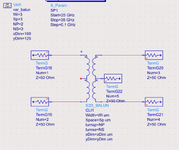anh56789
Junior Member level 2

Hello,
I am designing an RF balun to transform 50 Ohm single-ended to 100 Ohm differential. I used the Coilsys tool in ADS to auto-generate the EM model of the balun. I use 3 ports test bench for simulating the S parameters of the EM balun as the below figure.

The simulation results are quite bad, the input return loss is only > 16dB and the amplitude and phase imbalance are 1.3 dB and 45 degrees at Ka-Band.

But when I removed the ground at the output ports ( 2 and 3) the results are different from the first one. Here are the ungrounded test bench and its results. The return loss, amplitude, and phase imbalance are quite good when compared to the previous results. The return loss is > 28dB. The amplitude and phase imbalance are nearly zero.


I'm quite confused about the S parameter testbench. With the ungrounded test bench. The results are good. But I think when using this test bench, the effect of the parasitic capacitor from the secondary inductor to the substrate and primary inductor is removed due to the differential port ( as mentioned in this post https://muehlhaus.com/support/ads-application-notes/inductor-em-ports). Am I correct? Any insight on this problem would be appreciated. Thank you so much!!!
I am designing an RF balun to transform 50 Ohm single-ended to 100 Ohm differential. I used the Coilsys tool in ADS to auto-generate the EM model of the balun. I use 3 ports test bench for simulating the S parameters of the EM balun as the below figure.
The simulation results are quite bad, the input return loss is only > 16dB and the amplitude and phase imbalance are 1.3 dB and 45 degrees at Ka-Band.
But when I removed the ground at the output ports ( 2 and 3) the results are different from the first one. Here are the ungrounded test bench and its results. The return loss, amplitude, and phase imbalance are quite good when compared to the previous results. The return loss is > 28dB. The amplitude and phase imbalance are nearly zero.
I'm quite confused about the S parameter testbench. With the ungrounded test bench. The results are good. But I think when using this test bench, the effect of the parasitic capacitor from the secondary inductor to the substrate and primary inductor is removed due to the differential port ( as mentioned in this post https://muehlhaus.com/support/ads-application-notes/inductor-em-ports). Am I correct? Any insight on this problem would be appreciated. Thank you so much!!!


